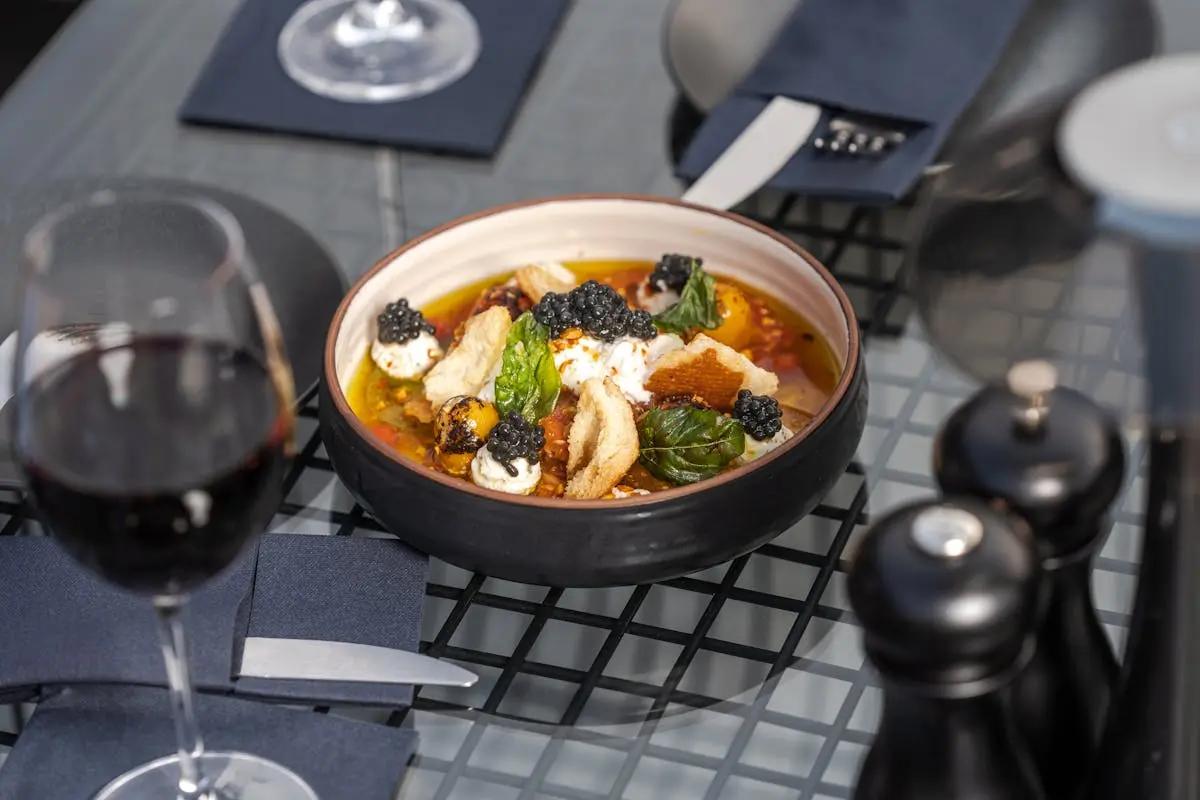Introduction to Luxury Caviar and Wine Pairing
Luxury caviar and fine wines share a prestigious spot in the realm of sophisticated dining. Pairing them can elevate any culinary experience, intertwining textures and flavors. Think of caviar, with its oceanic, slightly salty essence, and wine, with its expansive range from sweet to dry. Together, they create harmonies that can dazzle the palate. But starting with caviar and wine pairing isn’t just about matching any caviar with whatever bottle you have. It’s an art, blending the distinctiveness of luxurious caviar—beluga, ossetra, or sevruga—with the right wine, be it a crisp Champagne or a delicate white. To set the stage, understand that caviar, sourced from sturgeon fish, is celebrated for its rich, delicate flavors. When selecting a wine, aim for one that complements, not overshadows, this delicacy. This guide is your first step into a world where each bite and sip takes you deeper into a journey of refined tastes.
The Art of Selecting the Right Luxury Caviar
Selecting the right luxury caviar is all about understanding its flavor profile and how it matches up with your taste. Think of caviar like a fine wine; there are varieties that range from nutty and buttery to light and salty. Beluga, Ossetra, and Sevruga are the big three when it comes to luxury caviar. Beluga is prized for its large, silky beads and creamy texture. It’s top-tier and pairs well with a dry, crisp champagne. Ossetra falls in the middle with a nuttier flavor, perfect with a mineral-driven Chardonnay. Sevruga, smaller in bead size but packed with a bold, briny punch, matches nicely with a glass of dry Riesling. The key? Always aim for balance. You don’t want the wine overpowering the caviar or vice versa. A pro tip: keep it chilled. Luxury caviar should be served on ice to maintain its subtle flavors. And remember, a small spoon, preferably mother of pearl, is your tool of choice to avoid tainting the taste. So, start with the caviar’s flavor profile, find a companion wine that complements it, and enjoy the elegant dance of flavors on your palate.
Understanding Wine Profiles for Perfect Pairing
When it comes to pairing caviar with wine, it’s all about balancing flavors. Think of it like matching the vibe of a cool summer night with the perfect chill playlist. Wines vary greatly, from crisp whites to robust reds, and each type can complement different kinds of caviar. Here’s the lowdown: sparkling wines and champagne are your go-to’s for almost any caviar. Their bubbles and slight acidity cut through the richness of caviar, making each bite and sip a symphony in your mouth. Dry white wines, think Sauvignon Blanc or Chardonnay, are also winners. They’re like that crisp, fresh breeze that pairs so well with the salty ocean vibe of caviar. Reds are tricky but not off-limits. Aim for lighter, fruitier reds like Pinot Noir if you’re bold enough to go there. Remember, it’s about matching weight and power. Light caviar, like the delicate roe from trout, plays well with subtle wines. In contrast, the bold flavors of beluga or oscietra caviar can handle stronger, more aromatic wines. Bottom line: match the intensity, and you’ll be golden.
Top Wine Choices for Different Types of Luxury Caviar
When it comes to heightening the luxury of caviar, pairing it with the right wine is key. Start with Beluga caviar, which is known for its buttery, rich flavors. A dry Champagne or a crisp Chardonnay complements Beluga beautifully, adding a refreshing contrast. Moving on to Osetra caviar, with its nuttier undertones, look for a dry Riesling or a light-bodied Pinot Grigio. These wines bring out Osetra’s unique taste without overpowering it. For the more robust Sevruga caviar, a minerally Sancerre or Sauvignon Blanc can enhance its pronounced flavors. Finally, if you’re indulging in the subtle and delicate Kaluga caviar, opt for a vintage Champagne or a soft, aged Chardonnay. These pairings ensure that each spoonful of caviar is matched with a sip of wine that complements or intriguingly contrasts its flavors, elevating your dining experience to a new level of sophistication. Remember, the key is balance; the wine should never overshadow the caviar’s taste.
How to Prepare Your Palate for Caviar and Wine
To truly enjoy the luxury of caviar and wine together, your palate needs a bit of prepping. Start by cleansing your palate. This means no strong coffees or spicy foods before your tasting. These intense flavors can overshadow the delicate nuances of both caviar and wine. Next, drink plenty of water. Hydration helps reset your taste buds. But, keep it simple. You don’t want anything flavored or sparkling, just plain water will do the trick. Now, let’s talk timing. Eat a light meal beforehand. You want to avoid coming to the tasting overly hungry, which can make the flavors feel too intense, or worse, make you focus more on filling your stomach than enjoying the delicacies in front of you. Finally, familiarize yourself with the caviar and wine types you’ll be trying. Understanding their origins, processing, and flavor profiles can enhance your appreciation and help your palate navigate the intricate dance of flavors you’re about to experience. Remember, this isn’t a race. Take your time, savor each bite and sip, and let the luxurious flavors unfold.
Setting the Scene: The Perfect Atmosphere for Caviar and Wine Tasting
Creating the right atmosphere is crucial for a luxurious caviar and wine tasting experience. Imagine a space that feels both elegant and comfortable. Dim the lights slightly to create a soothing ambiance. Use soft, ambient lighting—perhaps candles or a dimmed chandelier—to add a touch of sophistication. The table setting should match the evening’s high-quality vibe. Opt for crisp, white linen tablecloths and ensure every glass shines. When it comes to music, choose something gentle and instrumental to play in the background. This sets a serene stage without overpowering guests’ conversations or the subtleties of the flavors they’re about to enjoy. Now, the temperature matters for both the caviar and the wine. Keep the caviar chilled until it’s time to serve, and ensure your wines are at the perfect serving temperature—whites and sparkling wines cool, reds slightly below room temperature. With each detail, you’re not just setting a table; you’re crafting an experience that enhances the delicate balance of flavors between the caviar and wine. Remember, the goal is to create a seamless blend of comfort, elegance, and sensory delight, setting the perfect scene for an unforgettable tasting journey.
Expert Tips on Serving and Presenting Luxury Caviar
When serving luxury caviar, keep it simple to let its taste shine. First, caviar should be ice cold, so place the tin on a bed of crushed ice. Use mother-of-pearl, bone, or glass spoons because metal utensils can alter caviar’s flavor. Serve it straight from the tin or on a blini or small potato for a traditional touch. Avoid overpowering garnishes. Fine caviar needs minimal additions – maybe a dollop of crème fraîche or a sprinkle of chopped chives on top. When it comes to presentation, elegance is key. Choose minimal, classy dishes and let the caviar’s appearance and aroma speak for itself. For an added luxurious experience, pair it with a glass of chilled champagne or a crisp, dry white wine. This pairing elevates the flavors of both the caviar and the wine, making for an unforgettable dining experience. Remember, the focus is on the caviar, so keep the presentation and accompaniments refined and understated.
The Do’s and Don’ts of Caviar and Wine Pairing
When pairing caviar and wine, think balance. You want the wine to complement, not overpower, the delicate flavors of the caviar. Do choose a wine that matches the richness of the caviar. For instance, a buttery Chardonnay pairs well with creamy caviar. Don’t go for a wine that’s too acidic or sweet, as it can clash with the caviar’s flavor. Champagne or a crisp, dry white wine like a Sauvignon Blanc is almost always a safe bet. They’re light enough to let the caviar shine while providing a refreshing contrast. Do consider the serving temperature. Caviar should be served cold, and so should your wine. A chilled wine enhances the caviar experience, highlighting its flavors without dulling your palate. Don’t forget about the texture. Caviar has a unique, slightly oily texture that can be either complemented or contrasted with your wine choice. A rule of thumb is to pair similar textures for harmony or go for a contrast to create a more dynamic tasting experience. And lastly, do experiment but within reason. It’s okay to try new pairings, but always keep the balance in mind. Stick to these guidelines, and your caviar and wine pairing will elevate any dining experience.
Creative Caviar Pairings with Uncommon Wines
When you think caviar, you likely think champagne. But let’s shake things up. Pairing caviar with wines beyond the bubbly can elevate your dining to a new level. Start with a crisp, unoaked Chardonnay. Its lightness and slight acidity bring out caviar’s briny depths without overwhelming its delicate flavor. Venture next into the world of dry Rieslings. Their balance of sweetness and acidity complements the saltiness of the caviar, enhancing its rich taste. Now, for something bolder, try a young Pinot Noir. Yes, a red! Select one that’s light-bodied and low in tannins to avoid overpowering the caviar. This unusual pairing brings a unique blend of earthiness to the experience. Lastly, Sauternes, with its sweet, complex profile, offers a surprising contrast that can highlight the creamy textures and nutty flavors in some caviars. Remember, the key is to keep the wine’s body and flavors in mind; you want them to complement, not dominate, the caviar. Experiment and find your perfect match.
Concluding Thoughts on Mastering the Art of Caviar and Wine Pairing
Mastering the art of caviar and wine pairing elevates your dining experience from good to unforgettable. Remember, pairing is more about balance than strict rules. Whether you prefer the buttery richness of Beluga or the subtle saltiness of Ossetra, there’s a wine out there that will enhance its flavor, not overpower it. Start with lighter wines and caviars, then gradually move to the more intense flavors. Trust your palate, experiment, and don’t be afraid to break traditional pairing guidelines to discover what combinations resonate with you. Ultimately, the goal is to enjoy and appreciate the luxurious experience that caviar and wine bring to the table. Cheers to your culinary adventure!

